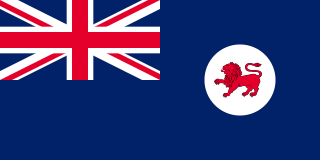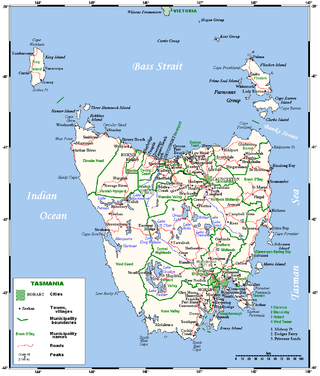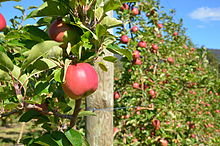
Tasmania is an island state of Australia. It is located 240 kilometres to the south of the Australian mainland, and is separated from it by the Bass Strait. The state encompasses the main island of Tasmania, the 26th-largest island in the world, and the surrounding 1000 islands. It is Australia's smallest and least populous state, with 573,479 residents as of June 2023. The state capital and largest city is Hobart, with around 40% of the population living in the Greater Hobart area. Tasmania is the most decentralised state in Australia, with the lowest proportion of its residents living within its capital city.
Perry or pear cider is an alcoholic beverage made from fermented pears, traditionally in England, parts of South Wales, France, Canada, Australia, and New Zealand. There is growing interest in artisanal perry production in the fruit-growing regions of the northwest United States.

Lake Pedder, once a glacial outwash lake, is a man-made impoundment and diversion lake located in South West Tasmania, Australia. In addition to its natural catchment from the Frankland Range, the lake is formed by the 1972 damming of the Serpentine and Huon rivers by the Hydro-Electric Commission for the purpose of hydroelectric power generation. Consequently, the lake is also known, somewhat derisively, as the Huon-Serpentine Impoundment.

Huon Valley Council is a local government body in Tasmania, covering most of the south of the state. Huon Valley is classified as a rural local government area and has a population of 17,219, towns and localities of the region include Cygnet, Dover, Franklin, Geeveston, Southport and the largest principal town, Huonville.

HuonvilleHYOO-on-vil is a town located on the banks of the Huon River in the Huon Valley, in the south-east of Tasmania, Australia. It serves as the administrative centre of the Huon Valley Council and is the largest town in the Huon Valley region. Situated approximately 38 kilometres south of the state capital, Hobart, Huonville acts as a gateway to Tasmania’s wilderness areas and the Southwest National Park.

South Hobart is one of Hobart's inner suburbs. It is bound by Dynnyrne, Fern Tree, West Hobart and the Hobart City Centre.

The Huon River is a perennial river located in the south-west and south-east regions of Tasmania, Australia. At 174 kilometres (108 mi) in length, the Huon River is the fifth-longest in the state, with its course flowing east through the fertile Huon Valley and emptying into the D'Entrecasteaux Channel, before flowing into the Tasman Sea.

The Australian wine industry is one of the world's largest exporters of wine, with approximately 800 million out of the 1.2 to 1.3 billion litres produced annually exported to overseas markets. The wine industry is a significant contributor to the Australian economy through production, employment, export, and tourism.

The Huon Valley, or simply the Huon, is a valley and geographic area located in southern Tasmania, Australia. The largest town is Huonville, with other smaller towns spread across the area. It includes Australia's most southern permanent settlement at Southport. The Huon Valley Council area had a population of 15,140 in 2011. The Huon Valley is known for its apple growing industry and its role in Tasmania’s aquaculture and tourism sectors.

South West Tasmania is a region in Tasmania that has evoked curiosity and wonder during the period of European presence on the island.

Tasmanian wine is wine produced in the Australian state of Tasmania. Located at a more southerly latitude than the rest of Australia's wine regions, Tasmania has a cooler climate and the potential to make distinctly different wines than in the rest of the country. The area grows primarily Pinot noir, Chardonnay and Sauvignon blanc, with some smaller plantings of Riesling, Pinot gris and Cabernet Sauvignon. Global warming has had positive effects on the Tasmanian wine industry, allowing most of the grapes in the past few vintages to ripen fully and produce more vibrant wine.
The Weld Valley is a valley located in southern Tasmania. It is an area of aboriginal cultural heritage and natural history within the Tasmanian Wilderness World Heritage Area. The valley stretches north-west of Huonville and is approximately 50 kilometres (31 mi) west of Hobart.
In the Australian state of Tasmania, there are many areas which are commonly known by regional names. Regions are areas that share similar characteristics. These characteristics may be natural such as the Furneaux Islands, the coastline, or the Central Highlands. Alternatively, the characteristics may be cultural, such as a viticulture land use. Tasmania is divided by numerous regional boundaries, based on different characteristics. In many cases boundaries defined by different government agencies are coterminous and are often cited by the Australian and local media that tend to distinguish between North West, West Coast, Southern, and East Coast.

Ranelagh is a township in the Huon Valley of Tasmania, Australia. Adjacent to Huonville, it serves as a residential area for commuters, a tourist destination, and a hub for agricultural activities. At the 2021 census, Ranelagh had a population of 1,484.

Castle Forbes Bay is a small locality in the Huon Valley, Tasmania. It is part of the Huon Valley Council. Located on the shore of the Huon River, it is a primary agricultural region and was historically a center of apple growing. Apples would be shipped from the waterfront at Castle Forbes Bay to Hobart, for export. Castle Forbes Bay's landscape is still shaped by apple orchards, though many of them are now disused or empty of trees. A large number of pickers huts, garages and apple packings dot the scenery, considered the possibly best preserved orcharding landscape in Australia.

The Avalon Theatre is a historic former Temperance Hall, theatre and cinema in Hobart, Tasmania, Australia.

The Derwent Valley is a river valley and geographic area located in southern Tasmania, Australia. The largest town is New Norfolk, with other smaller towns spread across the area. The Derwent Valley area had a population of 10,942 in 2021. Commencing at Lake St Clair and spanning 239 kilometres (149 mi) to the state capital of Hobart, the River Derwent receives contributions from numerous tributaries and plays a role in Tasmania's intricate hydroelectric system at certain points. Renowned for its agricultural output, the Derwent Valley was initially settled by British colonists during the 1800s. Prior to colonisation, the area was inhabited by the Leenowwenne peoples of the Big River district.

The Mersey Valley is a valley and geographic area in the northern region of Tasmania, Australia. It is named after the Mersey River, which flows through its length, providing a focal point for agriculture, tourism, and hydroelectric power generation. The valley includes the towns of Devonport, Latrobe, and Sheffield.
Tasmanian apples are a significant agricultural product of the Australian state of Tasmania. Known historically as "the Apple Isle," Tasmania remains Australia’s second-largest apple producer. The first apple tree was planted on Bruny Island in 1788, and by the 20th century, Tasmania had become one of the world's leading apple exporters. Although production has declined in recent decades, apples are still grown in significant quantities, particularly in southern Tasmania. In 2023, Tasmania produced over 29,000 t of apples, accounting for 10% of Australia’s total apple production.


















